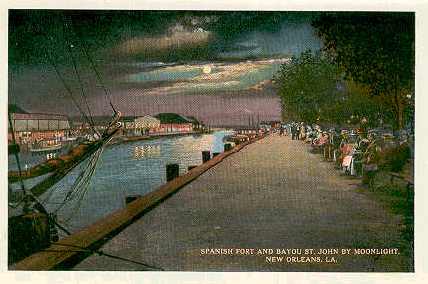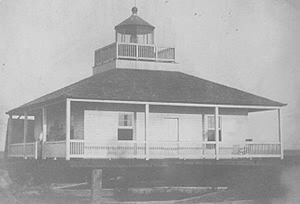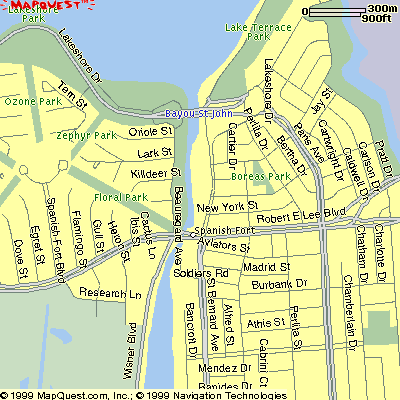Spanish Fort/Bayou St. John/Old Beach
Click to hear Armand J. Piron with Peter Bocage (A.J.Piron & his Novelty Orchestra) 1928 recording of 'New Orleans Joys', as it was heard at Tranchina's Restaurant in Spanish Fort

Postcard Circa 1915.
Originally an active Military Fort, built in 1779, to protect the city from invasion via the Lake, this area later became an entertainment district filled with amusement parks, restaurants, camps, and jazz.

Spanish Fort is located near Robert E. Lee Blvd. and Bayou St. John. This was where the lakeshore began before the massive land reclamation project during the 1920s & 30s which resulted in subdivisions and Lakeshore Drive. The photo shows the now defunct Bayou St. John Lighthouse.

Fort St. John
Located at the lake and Bayou St. John,
Spanish Fort is now quite far from the shoreline due to massive land reclamation
during the 1930's and 40's.
Looking at the map, all land north of Robert E.
Lee Blvd. was "reclaimed" from the lake. The fort originally bordered the
shoreline of Lake Pontchartrain.
When the fort was no longer needed, the land was sold to an amusement park
vendor who renamed it Spanish Fort. Later this became the 1st location of
Pontchartrain Beach Amusement Park. Because of this, many old timers called Fort
St. John/Spanish Fort "The Old Beach".
It's history is long and
interesting.
In 1812, New Orleans became part of the United States after the Louisiana
Purchase. The wealthy spent their leisure time on the lake shore at several
exclusive resorts, eating at the famous restaurants, gambling and enjoying the
lake breezes. The first resort to open is at Spanish Fort at the mouth of Bayou
St. John.
Source: Save Our Lake Foundation

Postcard circa 1912
Over the years, Spanish Fort changed hands quite a few times. There were also
lawsuits disputing its ownership, so it may be somewhat difficult to easily
explain who owned it throughout its history as a recreation area. I’m afraid I
can’t provide details about ownership of the park rides since amusement rides
were not as well-documented as real estate. Quite often, rides were owned by
out-of-town investors but operated by local people.
I’ve observed that
popular amusement places tend to be among the most poorly documented historic
sites. I think people just took them for granted, rarely saving photos or
otherwise documenting facts concerning the places where they enjoyed their
leisure hours. Unless more people who remember the old parks and theaters share
their memories with others, firsthand information about those places will be
forever lost.
In 1823, by a special act of Congress, Harvey Elkins
purchased the Spanish Fort site. Within two years, Elkins had built a hotel on
the site, thus beginning Spanish Fort’s century-long reputation as a popular
resort. It didn’t take long to attract international attention. In 1828, his
highness Bernhard, Duke of Saxe-Weimar-Eisenach, published both English and
German editions of his Travels through North America, during the years 1825 and
1826. In this narrative, Duke Bernhard mentions traveling through the Rigolets
and Lake Pontchartain, noting that a tavern was then being erected at the site
of the old Spanish fort on Bayou St. John.
Ownership soon passed from
Elkins to John Slidell; later, the New Orleans City and Lake Railroad would own
the site before selling it, in 1877, to Moses Schwartz. It was Schwartz who
first developed the amusement park that operated at Spanish Fort until the late
1920s. New Orleans Public Service would own the property before, in 1937,
turning it over to the Orleans Parish Levee Board.
Before 1900, Spanish
Fort was especially famous for its opera house and fine seafood restaurants.
Author William Makepeace Thackeray and Gen. Ulysses S. Grant were among the
celebrities who dined at Spanish Fort and later bragged about the experience. In
the early 1880s, during his great American tour, playwright Oscar Wilde lectured
a Spanish Fort audience about household beauty.
During its heyday as an
amusement park, from the 1880s to the 1920s, Spanish Fort faced stiff
competition from its nearby rival, West End. Although Spanish Fort had brief
moments of grandeur, sometimes proclaiming itself to be the “Coney Island of the
South,” the flood-prone park frequently fell on hard times, while West End
prospered. In 1903, streetcar service to the park was discontinued. Ownership
passed to the same streetcar company that operated the rival park, but Spanish
Fort would never attain West End’s fame or grandeur. Spanish Fort closed in
1926.
Source: New Orleans Magazine-Julia Street: Questions and Answers
about New Orleans
March 2000 - Vol. 34 - Issue 6 - Page - #346
http://publications.neworleans.com/no_magazine/34.6.-JuliaStreet.html